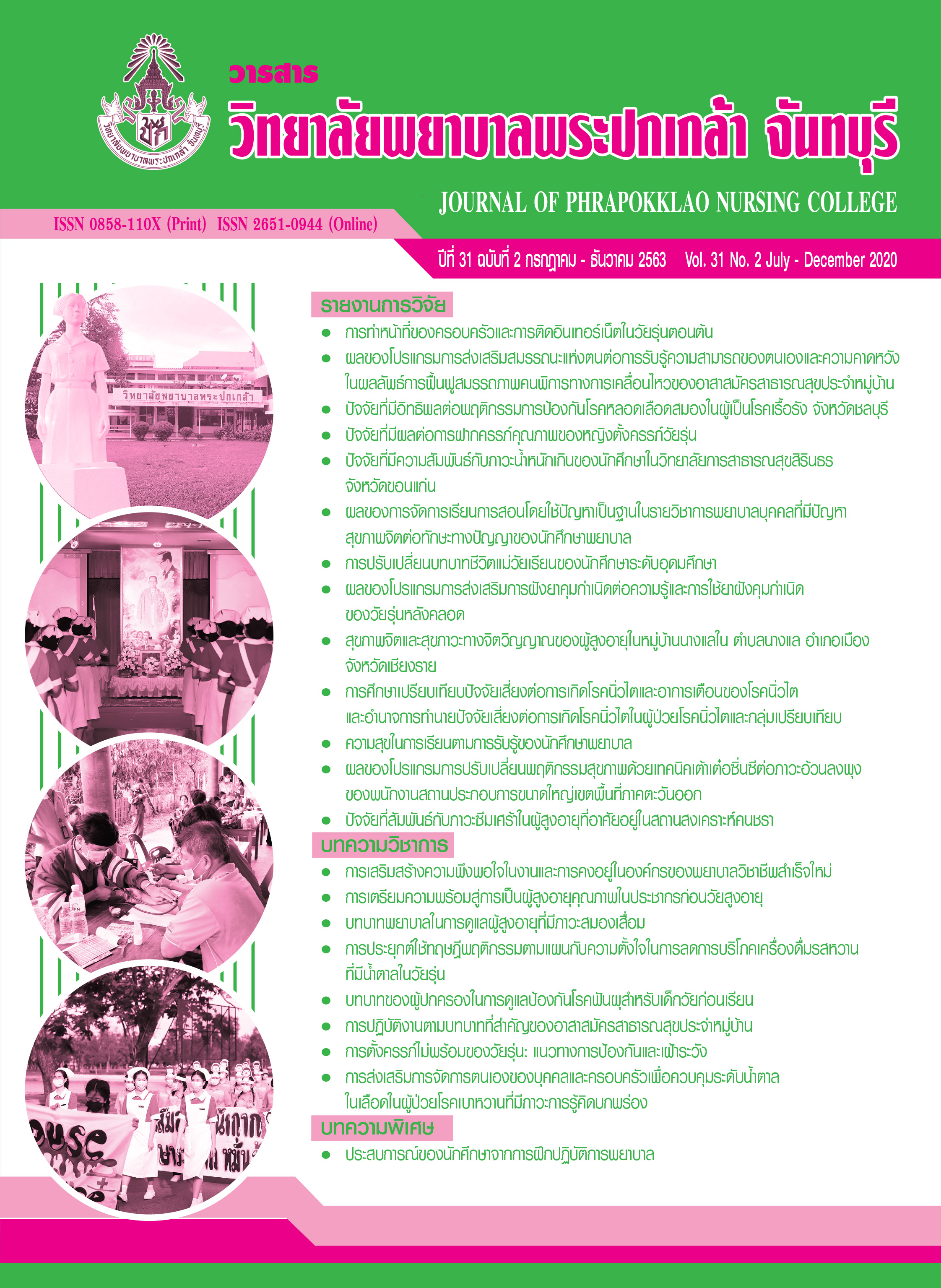Factors Associated with Overweight among Students in Sirindhorn College of Public Health, Khon Kaen
Keywords:
Modern lifestyle, Use of social media for playing games, OverweightAbstract
This cross-sectional analytical research aimed to identify factors associated with overweight among students in Sirindhorn College of Public Health, Khon Kaen. The samples consisted of 395 students studying in Sirindhorn College of Public Health, Khon Kaen in an academic year of 2018. The research instrument was a four-part questionnaire including personal characteristics, modern diet consuming behaviors with the reliability of .93, internet and social media using behaviors with the reliability of .89, and nutritional status. Data were collected in August, 2018. Statistics used for data analysis included frequency, percentage, mean, standard deviation, and multiple logistic regression analysis.
The research results revealed that factors statistically significant associated with overweight among students were alcohol drinking (AOR = 2.17, 95% CI = 1.24–4.67, p < .01) and use of social media for playing games more than 1 hour per time (AOR = 2.25, 95% CI = 1.18–4.29, p < .05).
This research suggests that educational executives should provide the campaign and enhance the culture to reduce alcohol drinking behaviors to students. In addition, educational executives should provide activities to promote students’ self-esteem in reducing the use of social media for playing games.
References
กัลยาณี โนอินทร์. (2560). ภาวะน้ำหนักเกินและโรคอ้วนในวัยเรียนและวัยรุ่นไทย. วารสารพยาบาลทหารบก, 18(พิเศษ), 1–8.
จันทิรา ไชยศรี, กมลทิพย์ ขลังธรรมเนียม, และหทัยชนก บัวเจริญ. (2557). แนวปฏิบัติการพยาบาลเพื่อจัดการภาวะอ้วนในเด็ก: การสังเคราะห์งานวิจัย. วารสารพยาบาลทหารบก, 15(2), 360–367.
จินดารัตน์ สมใจนึก, และจอม สุวรรณโณ. (2563). ความสัมพันธ์ระหว่างอายุกับภาวะนํ้าหนักเกิน/อ้วนในกลุ่มวัยช่วงเปลี่ยนผ่านจากวัยรุ่นตอนปลายสู่วัยผู้ใหญ่ตอนต้น: การเปรียบเทียบความชุกในห้ากลุ่มอายุและสามกลุ่มอายุ. วารสารพยาบาลโรคหัวใจและทรวงอก, 31(1), 142–159.
ฉัตรฤดี สุบรรณ ณ อยุธยา, และพรพิไล เติมสินสวัสดิ์. (2560). ภาวะน้ำหนักเกินกับพฤติกรรมสุขภาพของนักศึกษาและบุคลากร ในมหาวิทยาลัยเทคโนโลยีราชมงคลพระนคร. ใน เอกสารรายงานประชุมวิชาการมหาวิทยาลัยเทคโนโลยีราชมงคล ครั้งที่ 9 (น. 350–360). นครปฐม: สำนักพิมพ์มหาวิทยาลัยเทคโนโลยีราชมงคลรัตนโกสินทร์.
ตวงพร กตัญญุตานนท์. (2554). ภาวะโภชนาการและพฤติกรรม 3 อ. ของนักศึกษาชั้นปีที่ 1 มหาวิทยาลัยหัวเฉียวเฉลิมพระเกียรติ. วารสาร มฉก.วิชาการ, 14(28), 67–84.
ทิพธัญญา หมื่นอภัย. (2562). พฤติกรรมการบริโภคกาแฟของนักศึกษาวิทยาลัยการสาธารณสุขสิรินธร จังหวัดขอนแก่น (รายงานผลการวิจัย). วิทยาลัยการสาธารณสุขสิรินธร จังหวัดขอนแก่น.
ธัญดา สกุลภัณฑารักษ์. (2562). ปัจจัยที่มีความสัมพันธ์กับพฤติกรรมการบริโภคหมูกระทะบุพเฟ่ต์ของนักศึกษาวิทยาลัยการสาธารณสุขสิรินธร จังหวัดขอนแก่น (รายงานผลการวิจัย). วิทยาลัยการสาธารณสุขสิรินธร จังหวัดขอนแก่น.
ภูเบศร์ สมุทรจักร, และมนสิการ กาญจนะจิตรา. (2557). พฤติกรรมบริโภคนิยมในวัยรุ่นไทยและปัจจัยที่เป็นสาเหตุ. วารสารธรรมศาสตร์, 33(1), 46–69.
มโนลี ศรีเปารยะ เพ็ญพงษ์. (2559). พฤติกรรมการบริโภคอาหารของกลุ่มนักเรียนและนักศึกษาในจังหวัดสุราษฎร์ธานี. วารสารวิทยาการจัดการ, 3(1), 109–126.
วารินทร์ มากสวัสดิ์. (2559). ความสัมพันธ์ระหว่างการรับรู้ความสามารถแห่งตนกับการมีกิจกรรมทางกายของวัยรุ่นตอนต้นที่มีภาวะน้ำหนักเกินในกรุงเทพมหานคร (วิทยานิพนธ์ปริญญามหาบัณฑิต). กรุงเทพฯ: จุฬาลงกรณ์มหาวิทยาลัย.
วิชัย เอกพลากร. (2557). รายงานการสำรวจสุขภาพประชาชนไทยโดยการตรวจร่างกาย ครั้งที่ 5 พ.ศ. 2557 (รายงานผลการวิจัย). นนทบุรี: สถาบันวิจัยระบบสาธารณสุข.
สานิตย์ หนูนิล, และกนกวรา พวงประยงค์. (2562). ปัจจัยที่มีผลต่อรูปแบบการดำเนินชีวิตของคนรุ่นใหม่ในชนบทไทย. วารสารพัฒนาสังคม, 21(2), 176–195.
สำนักงานกองทุนสนับสนุนการสร้างเสริมสุขภาพ. (2559). 6 พฤติกรรมบั่นทอนสุขภาพ หนุ่มสาววัยทำงาน. สืบค้นจาก http://www.thaihealth.or.th/Content/30835-html
สำนักงานกองทุนสนับสนุนการสร้างเสริมสุขภาพ. (2563). จับตาทิศทางสุขภาพคนไทย ปี 2563. สืบค้นจาก https://resourcecenter.thaihealth.or.th
อุรุวรรณ แย้มบริสุทธิ์, และนฤมล สุวรรณอ่อน. (บ.ก.). (2552). โภชนาการกับเด็ก (พิชิตอ้วน). กรุงเทพฯ: สารคดี.
Al-Nuaim, A. A., Al-Nakeeb, Y., Lyons, M., Al-Hazzaa, H. M., Nevill, A., Collins, P., & Duncan, M. J. (2012). The prevalence of physical activity and sedentary behaviours relative to obesity among adolescents from Al-Ahsa, Saudi Arabia: Rural versus urban variations. Journal of Nutrition and Metabolism, 2012, 417589. doi:10.1155/2012/417589
Battista, K., & Leatherdale, S. T. (2017). Estimating how extra calories from alcohol consumption are likely an overlooked contributor to youth obesity. Health Promotion and Chronic Disease Prevention in Canada, 37(6), 194–200. doi:10.24095/hpcdp.37.6.03
Brown, C. L., Halvorson, E. E., Cohen, G. M., Lazorick, S., & Skelton, J. A. (2015). Addressing childhood obesity: Opportunities for prevention. Pediatric Clinics of North America, 62(5), 1241–1261. doi:10.1016/j.pcl.2015.05.013
Centers for Disease Control and Prevention. (2020). Overweight & obesity; Defining adult overweight and obesity. Retrieved from https://www.cdc.gov/obesity/adult/defining.html
Dickey, J., & Sullivan, J. (2007). Generation shift in media habits. Media Week, 17(7), 10.
Gurnani, M., Birken, C., & Hamilton, J. (2015). Childhood obesity: Causes, consequences, and management. Pediatric Clinics of North America, 62(4), 821–840. doi:10.1016/j.pcl.2015.04.001
Hsieh, F. Y., Bloch, D. A., & Larsen, M. D. (1998). A simple method of sample size calculation for linear and logistic regression. Statistics in Medicine, 17(14), 1623–1634. doi:10.1002/(sici)1097-0258(19980730)17:143.0.co;2-s
Karnik, S., & Kanekar, A. (2012). Childhood obesity: A global public health crisis. International Journal of Preventive Medicine, 3(1), 1–7.
Meier, J., & Crocker, M. (2010). Generation Y in the workforce: Managerial challenges. The Journal of Human Resource and Adult Learning, 6(1), 68–78. Retrieved from http://www.hraljournal.com/Page/8%20Justin%20Meier.pdf
Pulgaron, E. R. (2013). Childhood obesity: A review of increased risk for physical and psychological comorbidities. Clinical Therapeutics, 35(1), 18–32. doi:10.1016/j.clinthera.2012.12.014
Reilly, J. J., Methven, E., McDowell, Z. C., Hacking, B., Alexander, D., Stewart, L., & Kelnar, C. J. H. (2003). Health consequences of obesity. Archives of Disease in Childhood, 88(9), 748–752. Retrieved from https://adc.bmj.com/content/archdischild/88/9/748.full.pdf
Thiabrithi, S., Laohasiriwong, W., & Phajan, T. (2019). Modern lifestyles and overnutrition among undergraduate students in the northeast of Thailand. Indian Journal of Public Health Research and Development, 10(6), 637–643. doi:10.5958/0976-5506.2019.01348.2
Utter, J., Neumark-Sztainer, D., Jeffery, R., & Story, M. (2003). Couch potatoes or french fries: Are sedentary behaviors associated with body mass index, physical activity, and dietary behaviors among adolescents?. Journal of the American Dietetic Association, 103(10), 1298–1305. doi:10.1016/s0002-8223(03)01079-4
Vandelanotte, C., Sugiyama, T., Gardiner, P., & Owen, N. (2009). Associations of leisure-time internet and computer use with overweight and obesity, physical activity and sedentary behaviors: Cross-sectional study. Journal of Medical Internet Research, 11(3), e28. doi:10.2196/jmir.1084
Wei, C. N., Harada, K., Ueda, K., Fukumoto, K., Minamoto, K., & Ueda, A. (2012). Assessment of health-promoting lifestyle profile in Japanese university students. Environmental Health and Preventive Medicine, 17(3), 222–227. doi:10.1007/s12199-011-0244-8
World Health Organization. (2014). Noncommunicable diseases country profiles 2014. Retrieved from https://www.who.int/nmh/publications/ncd-profiles-2014/en/
World Health Organization. (2016). Obesity and overweight. Retrieved from http://www.int/mediacenter/factsheets/fs311/en/index.html
World Health Organization. (2020). Obesity and overweight. Retrieved from https://www.who.int/news-room/fact-sheets/detail/obesity-and-overweight
Downloads
Published
How to Cite
Issue
Section
License
Copyright (c) 2020 JOURNAL OF PHRAPOKKLAO NURSING COLLEGE

This work is licensed under a Creative Commons Attribution-NonCommercial-NoDerivatives 4.0 International License.
เนื้อความ ข้อมูล และรายการอ้างอิงที่ผู้เขียนใช้ในการเขียนบทความเพื่อลงตีพิมพ์ในวารสารวิทยาลัยพยาบาลพระปกเกล้า จันทบุรี ถือเป็นความคิดเห็นและความรับผิดชอบของผู้เขียน คณะผู้จัดทำวารสารไม่จำเป็นต้องเห็นพ้องด้วยหรือร่วมรับผิดชอบ
บทความที่ได้รับการลงตีพิมพ์ในวารสารวิทยาลัยพยาบาลพระปกเกล้า จันทบุรี ถือเป็นลิขสิทธิ์ของวารสารวิทยาลัยพยาบาลพระปกเกล้า จันทบุรี หากหน่วยงานหรือบุคคลใดต้องการนำส่วนหนึ่งหรือทั้งหมดของบทความไปเผยแพร่ต่อเพื่อวัตถุประสงค์ใด ๆ จะต้องได้รับอนุญาตจากบรรณาธิการวารสารก่อน



